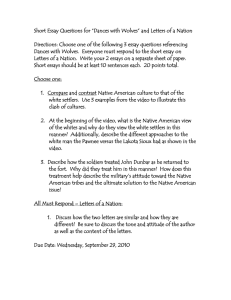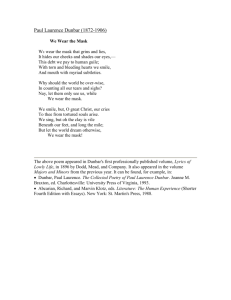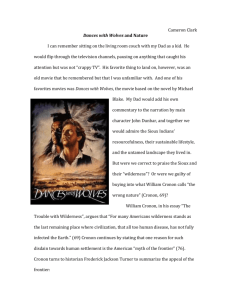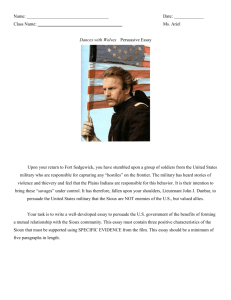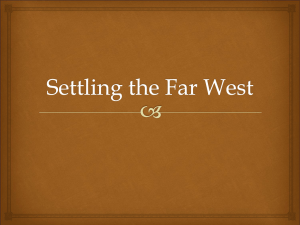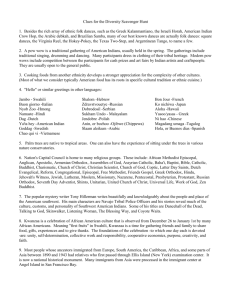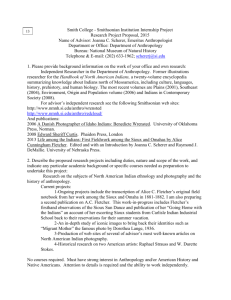496FraseBiblioProj1.doc
advertisement
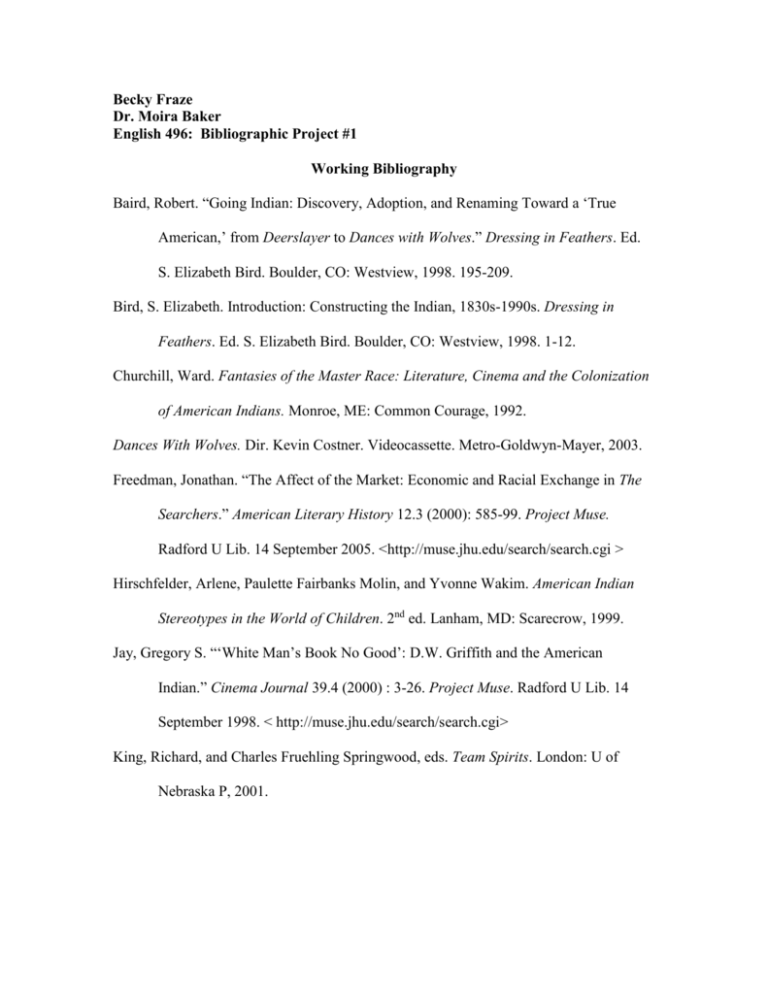
Becky Fraze Dr. Moira Baker English 496: Bibliographic Project #1 Working Bibliography Baird, Robert. “Going Indian: Discovery, Adoption, and Renaming Toward a ‘True American,’ from Deerslayer to Dances with Wolves.” Dressing in Feathers. Ed. S. Elizabeth Bird. Boulder, CO: Westview, 1998. 195-209. Bird, S. Elizabeth. Introduction: Constructing the Indian, 1830s-1990s. Dressing in Feathers. Ed. S. Elizabeth Bird. Boulder, CO: Westview, 1998. 1-12. Churchill, Ward. Fantasies of the Master Race: Literature, Cinema and the Colonization of American Indians. Monroe, ME: Common Courage, 1992. Dances With Wolves. Dir. Kevin Costner. Videocassette. Metro-Goldwyn-Mayer, 2003. Freedman, Jonathan. “The Affect of the Market: Economic and Racial Exchange in The Searchers.” American Literary History 12.3 (2000): 585-99. Project Muse. Radford U Lib. 14 September 2005. <http://muse.jhu.edu/search/search.cgi > Hirschfelder, Arlene, Paulette Fairbanks Molin, and Yvonne Wakim. American Indian Stereotypes in the World of Children. 2nd ed. Lanham, MD: Scarecrow, 1999. Jay, Gregory S. “‘White Man’s Book No Good’: D.W. Griffith and the American Indian.” Cinema Journal 39.4 (2000) : 3-26. Project Muse. Radford U Lib. 14 September 1998. < http://muse.jhu.edu/search/search.cgi> King, Richard, and Charles Fruehling Springwood, eds. Team Spirits. London: U of Nebraska P, 2001. Leuthold, Steven. “Historical Representation in Native American Documentary.” Ethnohistory 44.4 (1997) : 727-739. JSTOR. Radford U. Lib. 7September 2005 <http://www.jstor.org/search/AdvancedSearch> Neff, Heather. “Strange Faces in the Mirror: The Ethics of Diversity in Children’s Films.” The Lion and the Unicorn 20.1 (1996) : 50-65. Project Muse. Radford U Lib. 14 September 2005. < http://muse.jhu.edu/search/search.cgi> Owens, Louis. Mixedblood Messages: Literature, Film, Family, Place. Norman, OK: U of Oklahoma P, 1998. ---. Other Destinies: Understanding the American Indian Novel. Norman, OK: U of Oklahoma P, 1992. Pewewardy, Cornel. Why One Can’t Ignore Pocahontas. American Indian Stereotypes in the World of Children. Eds. Arlene Hirschfelder, Paulette Fairbanks Molin, and Yvonne Wakim. 2nd ed. Lanham, MD: Scarecrow, 1999. 171-174. Pocahontas. Dir. Mike Gabriel and Eric Goldberg. Videocassette. Buena Vista Home Entertainment, 1995. Pocahontas II: Journey To A New World. Dir. Tom Ellery and Bradley Raymond. Videocassette. Buena Vista Home Entertainment, 1998. The Searchers. Dir. John Ford. Perf. John Wayne. Warner Brothers, 1956. Becky Frase ENGL 496 Annotated Bibliography #1: 10 Annotations Baird, Robert. “Going Indian: Discovery, Adoption, and Renaming Toward a ‘True American,’ from Deerslayer to Dances with Wolves.” Dressing in Feathers. Ed. S. Elizabeth Bird. Boulder, CO: Westview, 1998. 195-209. Robert Baird’s essay was interesting, but at the same time somewhat confusing, because he sometimes seemed against certain portrayals or ideas, and then he’d turn around and say something that seemed to completely contradict what he just stated. However, Baird discusses the strategies in Kevin Costner’s film Dances with Wolves that are used to draw attention away from massacres in order to focus on smaller issues. Baird comments on the goal in American film and literature being more of a search for an American self, and how Dances with Wolves validates that, trying to convince the audience that “only by going backward into history, back into tribalism, could the American hero hope to go forward” (196). He also says that any White seeking to go-Indian has to confront “‘the massacre’” (200). There are three massacres in Costner’s film, and Baird points out that it’s the third one that “transforms the horror associated with that depiction into the Hollywoodsanctioned celebration of dispatching the bad men – the U.S. Cavalry…When the Lakota attack and kill Dunbar’s tormentors, one realizes that – even with ninety years of Hollywood history turned on its head – we have here the same cheer for the good guys…” (202). According to Baird this is a strategy for “resolving historical trauma,” to turn the focus off the massacre itself, and only one of three that he mentions (202). The next strategy to take the focus off the massacre is to present the audience with a tribe of “Noble Savages,” and a tribe of “old-fashioned savages,” basically good and bad Indians (202). In Dances with Wolves, the Noble Savages are The Sioux and the oldfashioned are the Pawnees. “This strategy has the function of addressing White historical fear and guilt within the same narrative, providing a way in which a fiction can remain simultaneously true to contradictory emotional responses to history” (202). The third strategy Baird talks about is renaming. The renaming scene in Dances with Wolves is when Lt. Dunbar is trying to get the wolf (who has been following him) to go away before he gets to the Lakota camp. Every time Dunbar chases the wolf, the wolf snaps at his heels, as if they are playing. In this scene some of the Lakota are watching from a distance, and though they don’t say anything, from their perspective it looks like Dunbar is dancing with the wolf. This allows the audience to also participate in renaming Dunbar based on what he’s doing and the title of the movie (203). Yet Baird says that the whole idea of renaming is to be attributed more, “about American romantic concepts of the Indian and the natural than it does about Hollywood storytelling” (203). Baird explains that the renaming is the “quintessential American myth – the self-made man rediscovering both America and, most important, his own true self in the process” (203). Baird then mentions an extended version (50 minutes longer) of the movie that was shown at one point, and one of the parts that was extended in this version was the night before the hunt (206). In the regular movie it shows Lt. Dunbar lying by himself with his voiceover saying he could not sleep with the Lakota that night, and the viewer assumes he’s just saving energy or nervous about the hunt the next day (206). However, in the extended version, the scene is longer and starts with Dunbar riding into camp, seeing a big fire and a wagon with buffalo hides, while his voiceover says: It was suddenly clear now what had happened, and my heart sank as I tried to convince myself that the white men who had been killed were bad people and deserved to die, but it was no use. I tried to believe that Windin-His-Hair and Kicking Bird and all the other people who shared in the killing were not so happy for having done it, but they were. As I looked at the familiar faces I realized that the gap between us was greater than I could ever have imagined. (206) Baird says that it then goes to the image of Dunbar lying by himself, but when you hear the voiceover saying he could not sleep with them that night, you have a whole different perspective on why. This was the last thing I was left to think about in Robert Baird’s essay, and I’m hoping I can find more information on this extended version of Dances with Wolves. Regardless of whether or not I can find it though, Baird presented new information to me about strategies used in the film, which are definitely going to prove useful in my thesis. Bird, S. Elizabeth. Introduction: Constructing the Indian, 1830s-1990s. Dressing in Feathers. Ed. S. Elizabeth Bird. Boulder, CO: Westview, 1998. 1-12. Because this essay was an introduction for the rest of the book, I expected it to just be an overview of the essays to follow. Bird did give a general idea, but also covered a variety of concepts. She started off talking about the Disney movie Pocahontas and how there were so many negative reactions when it came out in theaters. Over 100 Native American members of NatChat (a mailing list) signed a petition for parents to boycott the movie because of its historical inaccuracies (1). While watching Pocahontas, I was appalled by the lyrics to one of the songs, “Savages.” Bird mentions concerns that existed about that same song; while it was obvious the point of the Disney movie was not to endorse what the lyrics suggested, people were worried that the soundtrack – out before the movie was in theaters – would have the song taken out of context, encouraging feelings of hatred (1). Bird states that “no one could deny that Pocahontas bears little relationship to history,” and then proves her point by introducing the idea that the movie is all about mythmaking (2). “The point here is that the Pocahontas story, like other national myths about Indians who helped Whites, such as Squanto and Massasoit, are White mainstream myths” (2). She makes plenty of points that reiterate what I want to state in my paper, like how these constructed stories give people justification of what the Native Americans went through during colonization, and alleviate guilt people might feel because of it. “…after all, the ‘good’ Indians helped us out and recognized the inevitability of White conquest” (2). Bird talks about slow acceptance of Native Americans once they were thought of as powerless, and how once they were “no longer a threat,” they became “colorful and quaint” (4). While Bird focused more on the Disney Pocahontas movie, she also touched on Native Americans’ portrayal in general. “Now that the few ‘real’ (i.e., frozen in history) Indians remain to be viewed, mass culture has replaced them with movies, television, and romances, which are almost invariably set in the past. Opportunities to see contemporary Indians playing mainstream roles are few and far between” (4). She nails the point right on the head when she states, “However they are pictured, Indians are the quintessential Other, whose role is to be the object of the White, colonialist gaze” (4). In this introduction, S. Elizabeth Bird presents facts as examples of how Native Americans are inaccurately depicted, setting up the reader for the essay to come. Bross, Kristina. Dry Bones and Indian Sermons. Ithaca, NY: Cornell UP, 2004. This book was a great find! Bross covered a few different topics that I haven’t come across in previous research, and she has some great quotes I hope I can use. The name of this chapter is “Satan’s Captives, ‘Preying’ Indians, and Mary Rowlandson: Revising the American Captivity Narrative.” I wasn’t sure what Bross’ stance was (if she was in support of Mary Rowlandson’s captivity narrative or not), but I got a mix of both positive and negative views throughout the chapter. Bross starts off talking about Native Americans (in the 1600’s) that had converted to Christianity: “Although converted Indians faced racial prejudice, political rivalries, and competition even for their small landholdings, their transcultural physical appearance and settled praying towns did offer them a measure of physical security and the promise of a place within New England, albeit on the margins of English society” (147). I’ve been focusing more on the pressure that was on Native Americans to conform – reading about what happened after their assimilation was an interesting twist. However, it did not change my opinion whatsoever. Even after Native Americans conformed and changed to the religion of the Europeans, they were still not completely acknowledged, but banished to the outskirts of society. It was a lose lose situation: if they didn’t convert they were seen as heathen and evil, and if they did convert they were only slightly accepted. Furthermore, once the 1675 war between the colonists and an alliance of Native Americans started, all of the Christian-converted Native Americans were shunned (147). Bross also discusses the concept of Indians being prisoners. At first I thought she was referring to Europeans holding natives as captives, however, she clarifies that the Europeans saw Indian tribes as the captors. The natives were expected to renounce everything they had ever known and become Christian. Yet once again, it was a catch twenty-two because once the war started: “rather than ‘poor prisoners,’ Christian Indians became Satan’s instruments” (147). This then segues into the American captivity narrative, where Mary Rowlandson comes in: “In particular, Mary Rowlandson’s 1682 narrative turned American Literature and Indian representation firmly in the direction of racist exclusion or extermination” (148). Bross continues to explain how missionaries saw themselves (benefactors, soldiers for Christ), and how the Native Americans saw the missionaries: “Rather than being subject to Satan, Indian speakers report that they felt hemmed in by Christians. For many, the decision to pray was reached when they realized that the only way to avoid giving up their lands was to convert to Christianity” (152). It’s amazing how things didn’t change – Mary Rowlandson, John Smith, Kevin Costner – they all wanted Native Americans to change to fit a certain mold, and when they did, the effort wasn’t acknowledged, or better yet, brushed away, without a trace left behind. I’m really glad I read this article. It presented a few different points of views, and gave me good background knowledge that will be useful in supporting my thesis. Brown, Paul. “‘This thing of darkness I acknowledge mine’: The Tempest and the discourse of colonialism.” Political Shakespeare: Essays in Cultural Materialism. 2nd ed. Eds. Jonathan Dollimore and Alan Sinfield. London: Cornell UP, 1985. 48-71. The majority of this article discusses The Tempest, but there was some good information about the Pocahontas/John Rolfe story, which Brown parallels to parts of Shakespeare’s play. Brown provided some details about a letter John Rolfe wrote, which makes the movie Pocahontas II: Journey To A New World even more ridiculous. Brown starts off by informing the reader that in 1614 John Rolfe wrote a letter to the Governor, asking him to bless his marriage to Pocahontas. Brown states: “This remarkable document announces a victory for the colonialist project, confirming Rolfe in the position of coloniser and Pocahontas in the position of a savage other” (49). Rolfe’s letter implies that the only reason he married Pocahontas was because he was physically attracted to her, and he seems to be justifying it to the Governor: saying that it’s okay for him to be attracted to her because she has converted to Christianity, and he’s only attracted to her body, not her mind or soul (which might still have some savage in it). There is nothing even remotely close to this in the second movie Disney made – it still amazes me they were allowed to make a movie so incredibly inaccurate. Also misrepresented in the movie is Pocahontas’ first appearance before King James I. Brown mentions it in his essay: “After his initial calls for Rolfe to be denounced as a traitor, James I allowed the ‘princess’, newly christened ‘Lady Rebecca’, into court as visible evidence of the power of civility to transform the other” (50). First off, by the end of the movie John Rolfe and Pocahontas are in love, but not married, and are sailing away from England. Not to mention the fact that when she appears in front of King James (in the movie), she had not converted to Christianity and her name was definitely not Lady Rebecca. Additionally, Pocahontas died in England, after only nine days there, but of course there’s no allusion to this according to Walt Disney. I agree with Brown: “The Pocahontas myth was only beginning” (50). Although a lot of the information in this article was not pertinent to my thesis, what I found is going to help me a lot, and I think the strong arguments I have against Pocahontas II were made stronger because I read this. Campbell, James T. “‘Print the Legend’: John Wayne and Postwar American Culture.” Reviews in American History 28.3 (2000): 465-477. Project Muse. Radford U Lib. 7 September 2005. <http://muse.jhu.edu/search> This article provides the reader with a much closer, more in-depth look at John Wayne. The author, James Campbell, doesn’t seem to like or dislike John Wayne, but it was hard to tell at certain points in this article. He quotes plenty of people, some on why they like John Wayne, some on why they don’t. There are a lot of general assumptions and in a sense, stereotypes in this article. For instance, Campbell is talking about the influence Wayne had and says: “In the process, he became not only one of the most recognized figures in the world but one of the most influential, the seeming quintessence of American manhood” (Campbell 466). So the “quintessence of American manhood,” tossed women over his shoulder or spanked them on their backside (as was the case in most of Wayne’s films – if there were any women in the film at all), and then decided anyone different than him (namely, Native Americans) were the enemy and either killed them or pushed them aside? Later Campbell quotes Randy Roberts and James Olson, co-authors of John Wayne: American, stating: “‘Those who hope to understand America must understand John Wayne’s appeal’” (Campbell 467). So people who didn’t understand the appeal of John Wayne either couldn’t understand the United States as a country, or is it simply that those people could never be American? (These are definitely points I can work into my thesis). I found myself scoffing and even getting angry at some of the things people have said about John Wayne, but I think the quote that set me off the most was in reference to reactions people had to movies Wayne was in: “Jean Luc Goddard sat in a darkened Paris theater and wept as Wayne’s monomaniacal Ethan Edwards gathered Natalie Wood into his arms at the climax of John Ford’s The Searchers” (Campbell 466). You have got to be kidding me. The whole movie Wayne (Ethan), is searching for his niece Debbie and once he finds out she’s been living as a wife to an Indian he’s set on killing her because she’s no longer human to him. At the end of the movie he finally catches her and decides he doesn’t want to kill his niece and all of a sudden he’s a hero? That’s the scene that brought a famous French filmmaker to tears? I don’t even know how to respond to that because of the amount of shock I’m experiencing. Later on in the article, Campbell comments on the kinds of characters that Wayne plays: “With a few exceptions (The Searchers’ Ethan Edwards being the most conspicuous), Wayne’s characters were not Indian haters, but men who ‘knew’ and respected Indians and were esteemed by them in turn. Yet the conclusion was the same: the Indians must give way” (Campbell 469). I was really excited when I found this quote because it pretty much says John Wayne’s character is an Indian hater in The Searchers, and it drives home an even bigger point that I’m making in my thesis about Native Americans having to “give way,” which I can tie in with every other movie I’m doing. I’m glad I found this article because even though some of the quotes made me angry or irritated, that can sometimes be the best material to prove the point. I will definitely be using this article in my thesis. Churchill, Ward. Fantasies of the Master Race: Literature, Cinema and the Colonization of American Indians. Monroe, ME: Common Courage, 1992. Wow, talk about strong writing! The quote that opens up this chapter was said in 1964 by Stephan Feraca, a motion picture director: Now those movie Indians wearing all those feathers can’t come out as human beings. They’re not expected to come out as human beings because I think the American people do not regard them as wholly human. We must remember that many, many American children believe that feathers grow out of Indian heads. (231) The information I’m reading has started to build and reiterate itself quite well. Churchill makes a point similar to what Louis Owens said in his book, Other Destinies, stating that Indians have been restricted in “terms of the time of their collective existence” (232). As far as society is concerned Indians no longer exist, so when movies are made with Native American roles, the time frame is older, not present day. Because of this, Churchill says society as a whole does not take Native Americans seriously and does not see “…Native America as either an historical or topical reality” (234). Churchill also talks about how Hollywood defines Native Americans by Eurocentric values. In the past Hollywood has had white characters narrate the script of films that are supposed to be (in one way or another) about Native American culture, in addition to generally depicting Native Americans as unintelligent, ridiculous, or irrational (235-6): “Insofar as indigenous American and Euro-derived worldviews are radically and demonstrably different in almost every way, such a projection can only serve to misrepresent dramatically the native cultures involved and render them nonsensical at best” (235). Churchill is definitely the most authoritative author I’ve read so far, and nails down the point that Hollywood in general has been not only misrepresenting, and stereotyping, Native Americans, but also killing their cultural identity: It is elementary logic to realize that when the cultural identity of a people is symbolically demolished, the achievements and very humanity of that people must also be disregarded. The people, as such, disappear, usually to the benefit – both material and psychic – of those performing the symbolic demolition. There are accurate and appropriate terms which describe this: dehumanization, obliteration or appropriation of identity, political subordination and material colonization are all elements of a common process of imperialism. This is the real meaning of Hollywood’s stereotyping of American Indians. (239) Churchill quotes from General Phil Sheridan, “‘The only good Indian is a dead Indian’” (241), and then touches on the genocide that has been exacted on Native Americans. He compares Hollywood’s representation of Native Americans in film to the destruction the Third Reich would have made in the East in the ‘40s if Germany had won the war (240). Out of everything I’ve read so far Churchill has definitely made the biggest impact, and I know I’ll be able to use a lot of what I learned from his essays in my thesis. Churchill, Ward. Fantasies of the Master Race: Literature, Cinema and the Colonization of American Indians. Monroe, ME: Common Courage, 1992. This essay is only five pages long, but packed in as much information as ones that I’ve read that have been fifteen pages. Churchill expresses his opinion about the movie Dances with Wolves, but takes it a step farther and points out the inaccuracies about the film. He does note that Kevin Costner cast Indians in Indian roles, allows them to serve as more than props, and that the film is technically and historically accurate, but that’s about all he gives Costner credit for (244). Churchill states that the problem with the movie is not that the Native American culture is portrayed incorrectly, but rather that it’s barely portrayed at all. “Dances with Wolves is by no means a movie about Indians. Instead, it is at base an elaboration of movieland’s Great White Hunter theme, albeit one with a decidedly different (‘better’) personality than the usual example of the genre, and much more elegantly done” (245). Churchill states that the main character (Lt. Dunbar played by Kevin Costner), is “ultimately Eurocentric,” which would not be the case if the movie were about Native America. Instead, it’s a film about a white man trying to be accepted by the Lakota tribe; once that happens and he is accepted, he takes his woman (who, coincidentally, is white), and leaves. “So too do we encounter this contrived sense of sad inevitability in the closing scenes of Dances with Wolves, as Lt. Dunbar and the female ‘captive’ he has ‘recovered’ ride off into the proverbial sunset, leaving their Lakota ‘friends’ to be slaughtered by and subordinated to the United States” (245). The stereotype that Indians and their struggles are in the past is something I’ve found in my research – Churchill too mentions how there seems to be a mental block on realizing there could be problems that exist today for Native Americans (245). The essay ends with a bold statement from Churchill saying what is long overdue: If Kevin Costner or anyone else in Hollywood held an honest inclination to make a movie which would alter public perceptions of Native America in some meaningful way, it would, first and foremost, be set in the present day, not in the mid-19th century. It would feature, front and center, the real struggles of living native people to liberate themselves from the oppression which has beset them in the contemporary era, not the adventures of some fictional non-Indian out to save the savage. (246) I can’t even begin to categorize this essay as a movie review – the level of writing is much higher than that. However, it did give strong ideas and quotes about arguing against the movie Dances with Wolves. Dances With Wolves. Dir. Kevin Costner. Videocassette. Metro-Goldwyn-Mayer, 2003. This movie was nothing more than an excuse for Kevin Costner to assert his white superiority through his character John Dunbar. From the very start of the movie he’s a brave soldier, putting his boot back on his injured foot, toughing out the pain. When he tries to commit suicide (by riding between rows of shooting soldiers), he says “Forgive me Father,” and puts his arms out like he’s on a crucifix (Dances). The shots fired don’t kill him, so that must mean God intended him to live; when the General finds him laying on the field he tells his men to get his ambulance because they had an officer who’s “worth somethin’ layin’ here” (Dances). In Costner’s voice over he tells the audience: “In trying to produce my own death, I was elevated to the status of a living hero […] and on full recovery was given transfer to any station I desired” (Dances). Right. Because I’m sure that was exactly what happened to all Civil War soldiers who tried to kill themselves. When he gets to Fort Hayes, newly decorated Lieutenant Dunbar is re-assigned to Fort Hedrick, his guide a civilian named Timmons. The first time Dunbar displays his superiority in this movie is the first night he and Timmons are camping. He writes: “Were it not for my companion I’d be having the time of my life. I know he means well, but he is quite possibly the foulest man I’ve ever met” (Dances). The first insult about Native Americans though isn’t until they’re almost to the fort. Dunbar asks Timmons why they haven’t seen any Indians, and Timmons replies, “‘Indians! Goddamn Indians! You’d just as soon not see ‘em less in a basket or dead. Nothin’ but thieves and beggars’” (Dances). (I’m not exactly sure about the basket part of this quote – I replayed it four times because it was hard to understand what this character was saying). All that’s at the Fort are two shoddy buildings, and when Timmons argues with Dunbar about staying, Dunbar pulls his gun on him, telling Timmons that this is his (Dunbar’s) post and to get his “ass off the wagon and help me unload” (Dances). Again, the superior man gets his way. Timmons leaves, and while exploring the area around the fort, Dunbar discovers a dead deer in the lake, tries to cook it, and causes tons of black smoke, alerting two neighboring tribes to his presence. The first tribe (Pawnee) head to where the smoke came from (simply because it is smoke in their territory), whereas a man from the Sioux tribe goes into the fort while Dunbar is bathing, trying to figure out who is there. Dunbar sees the man and charges toward him, (completely naked) and the native flees. The Sioux and Pawnee are examples of the good Indian/bad Indian information I’ve read about in my research. Costner needed a tribe of Indians that the audience could hate, and one they could get attached to, so he made the Pawnee vicious and the Sioux curious. Meanwhile, Dunbar meets a wolf who comes around the fort, and dubs him TwoSocks because of his front white feet. Wind in His Hair (another Sioux member) also paid a visit to Dunbar, charging right up to him shouting “I am Wind in His Hair! I am Wind in His Hair! Do you see I am not afraid of you?” Dunbar decides to ride into the Sioux village, but on the way finds a woman who’s hysterical, and trying to kill herself. He returns her to the Sioux village and then leaves, seeing that he’s not exactly welcome. The Sioux Council decides to try and talk to Dunbar, thinking they can get medicine from him, and also find out how many more white men are coming. The Sioux pay a few visits to Dunbar, but can’t communicate because of the language barrier. Kicking Bird (a holy man of the Sioux tribe) talks to Stands with a Fist (the same woman Dunbar found and brought back to the village), telling her that he needed her to try and act as interpreter between him and Dunbar. She’s white, and Kicking Bird is like her father because he found her when she was little, after the Pawnee killed her family. Stands with a Fist says she can’t “make the white talk anymore,” and that “it is dead” to her (Dances). However, by the first time Dunbar comes to the village she has decided to interpret. That night though, Dunbar writes: “For some reason I am reluctant to answer all their questions. Maybe it’s a sense of duty, but something tells me not to say too much” (Dances). It seem like he’s trying to form a relationship, but at the same time he’s still waiting on the troops he was told would meet him at the fort; his conversing with the Sioux is more for company than anything else. Buffalo had always been a topic of conversation between Dunbar and Kicking Bird, because the lack of buffalo was affecting the Sioux’s needs for food and their hides for warmth. When Dunbar sees a herd of buffalo he rides into the Sioux’s camp to tell them, and accompanies them on the hunt. They come across a field of dead buffalo, skinned, but obviously only killed for sport. Dunbar starts to identify with the Sioux, thinking: “Who could do such a thing? The field was proof enough that it was a people without value, and without soul, with no regard for Sioux rides. The wagon tracks leading away left little doubt, and my heart sank as I knew it could only be white hunters” (Dances). Soon enough though, Dunbar is back to playing the heroic white man. During the actual buffalo hunt, one of the buffalo charges Smiles A Lot (a younger boy) and injures his horse, leaving Smiles A Lot defenseless on the ground. The buffalo then charges him, and Dunbar fires shots from his gun, killing him just in time, therefore saving Smiles A Lot’s life. He’s offered the heart of the buffalo by Wind in His Hair, and seems to be generally accepted. What’s ironic is even on the hunt, where Dunbar is completely inexperienced, he manages to save the day because of his gun, which of course is something only the white man has. The next big part of the movie is when Sioux warriors go on a war hunt for Pawnee, and Kicking Bird asks Dunbar to watch over his family while he’s gone. As Kicking Bird is leaving he tells Stands with a Fist that if she wants she can keep up with the “white talk,” to which she replies, “I like to make the talk” (Dances). She’s the only white woman in the tribe, speaking to the only white man around – she’s speaking her native language, something a little while ago she was convinced she couldn’t do, but now enjoys immensely. However, white superiority is not confined just to Dunbar’s character in this movie, it’s seen in Stands with a Fist as well. In the story of how she got her name (an old woman was calling her names and Stands with a Fist punched her), she reveals her superiority. She stood with a fist, and asked if anyone else wanted to call her a name, and since then no one has. When the Sioux find out Pawnee warriors are coming, Dunbar convinces the Sioux to use his rifles, because it will make “one warrior like two” (Dances), and the audience sees Dunbar and Stands with a Fist kill Pawnee warriors. You hear plenty of other gun shots and you see Pawnee warriors falling, but it’s one or the other. You either hear the gunshots while everyone is fighting, or you see a Pawnee warrior falling, but not both; except for Dunbar and Stands with a Fist – you know exactly who they kill. The Sioux win, because they have white man rifles, and in a sense they are now superior to the Pawnees because they’ve conformed to white standards. The blossoming romance continues between Dunbar and Stands with a Fist, and Kicking Bird’s wife tells him it makes sense for them to be together because “they are both white” (Dances). The implication there is it would not make sense if either were with someone who wasn’t white. Dunbar and Stands with a Fist get married, and when Dunbar tells Kicking Bird they’re trying to have a baby, Kicking Bird laughs and says that instead of Dances With Wolves they should call him Busy Bee (Dances). It’s a nice little pun, but it also completely discredits all the names of the members of the Sioux tribe, like they’re not good names, or even real names at that. Dunbar tells Kicking Bird what he’s been holding back on the whole time – that there are going to be a lot more white men coming this way. They talk to Ten Bears (the oldest native, and probably Chief of the tribe) about it, and he pulls out an old-fashioned helmet, talking about how many different groups have come through trying to take the land and destroy the Sioux people: “They all take without asking” (Dances). They decide to move to the winter camp, but Dunbar realizes in recovering his possessions from the fort, the one thing he forgot was his journal, which anyone could use to track him and the tribe. He leaves to get it, and consequently will have to catch up with the tribe afterwards. Recovering the journal seems like a nice gesture because he doesn’t want the Army following or endangering the Sioux, yet this is also a way of leaving no trace that this tribe ever existed. When he returns to Fort Hedrick, there are troops there who think he’s an Indian. They kill his horse, and bring him into one of the two buildings; a Lieutenant questions him, and when Dunbar tells him about the journal, the Lieutenant doesn’t believe him because no one has found it. (The audience finds out later one of the men was hiding it). When Dunbar does not agree to help them as an interpreter for any Indian tribes in the area, he’s told he’s being taken back to Fort Hayes where he will be hanged. As he’s escorted out of the building at one point you can hear background soldiers telling each other that he’s a Lieutenant, even though he looks like an Indian and they don’t know if they should “salute him or shoot him” (Dances). Several Sioux members are following the wagon that Dunbar’s in, and they attack the army men to free Dunbar. When Dunbar gets back to the winter village, he tells the Council they should move the village again because the Army will be looking for him. He also tells them he will be leaving the tribe, because the Army sees him as a traitor and that brings danger to them. Stands with a Fist tells him she will go with him because: “My place is with you, I go where you go,” and Smiles A Lot gives Dunbar his journal that he recovered from the river (after the attack on the Army men) (Dances). As Dunbar and Stands with a Fist are leaving the village, Wind in His Hair shouts: “‘Dances With Wolves! Dances With Wolves! I am Wind in His Hair! Can you see I am your friend? Can you see that I will always be your friend?” (Dances) Army soldiers find the village after the Sioux are gone, and at the end there’s a wolf howling as you see Dunbar and Stands with a Fist making their way along a path, the snow covering their tracks behind them – no way to be found. I know plenty of people who would describe the movie Dances with Wolves as a good movie with a bittersweet ending. That is not the case at all. The Sioux wouldn’t have faced most of the problems they dealt with in the movie if it wasn’t for the white Lieutenant Dunbar. They would not have had to move their village twice, or be worried about Army soldiers searching for someone they considered a traitor. In this movie the white man pretty much used the Native Americans. He learned what he wanted to learn, he “experienced” the frontier (why he went to Fort Hayes in the first place), he acquired a wife who, coincidentally happens to be white, and now he’s moving along because he brings dangers to the tribe. All of this was set in the past, causing the audience to shed a tear at the injustice done to these native people, and the bravery of that heroic white man. Jan Mohamed, Abdul R. “The Economy of Manichean Allegory.” The Post-Colonial Studies Reader. Ed. Bill Ashcroft, Garete Griffiths, and Helen Tiffin, New York: Routledge, 1995. 18-23. In his article, “The Economy of Manichean Allegory,” Abdul R. Jan Mohamed is mainly discussing colonialist literature, but presents several ideas I think I can use about films in my thesis. He starts off talking about the European responding to natives in terms of identity or difference. When the European identifies with the native they judge the “Other according to [their] own cultural values,” whereas when they look at the differences between them and the native they retreat to the “security of [their] ‘cultural perspective’” (18). This is a no-win situation – either way the native is judged according to the colonist’s values and is ultimately found lacking. In order to understand another culture, one has to break away from the values of what one knows, to see the other culture in an unbiased way. Unfortunately, that’s not what happens in any of the four films I’m focusing on for my thesis. The white race is seen as superior, and the Native Americans are seen as inferior. Jan Mohamed touches on this as well: “Moreover, the colonizers invariable assumption about his moral superiority means that he will rarely question the validity of either his own or his society’s formation and that he will not be inclined to expend any energy in understanding the worthless alterity of the colonized” (18). This is depicted by General Radcliffe in Pocahontas and Pocahontas II, and Ethan in The Searchers. “[…] instead of seeing the native as a bridge toward syncretic possibility, it uses him as a mirror that reflects the colonist’s self-image” (19). Jan Mohamed adds, that to say the word, “…‘native’ is automatically to say ‘evil’ and to evoke immediately the economy of the Manichean allegory” (19). Jan Mohamed introduces two kinds of texts: symbolic, and imaginary. Although I’m working with films in my thesis, the views that these texts reflect are also apparent in the movies I’m studying. In imaginary texts the colonist: “Threatened by a metaphysical alterity that he has created, he quickly retreats to the homogeneity of his own group. Consequently, his psyche, and text tend to be much closer to and are often entirely occluded by the ideology of his group” (19). This is true of Radcliff in the first Pocahontas movie, and true of almost everyone in Pocahontas II. The colonists expect something from or of the Natives (for instance, finding gold), and when those expectations are not met (or the gold not found), Radcliff convinces the colonists that the natives must be lying to them, and how they can only trust each other. The symbolic text is more open to looking at the differences in the two cultures, but the type that is relevant in the four films is the type that attempts to find solutions to the differences in the cultures (19). This reminds me of the first time in the Disney move Pocahontas and John Smith are talking, and he says that the colonists have “improved the lives of savages all over the world” (Pocahontas). Smith sees the difference between the two cultures, but assumes the solution is for the Natives to conform to the European lifestyle. This goes hand in hand with another quote I found from the article: “The colonialist’s military superiority ensures a complete projection of his self on the Other: exercising his assumed superiority, he destroys without any significant qualms the effectiveness of indigenous economic, social, political, legal, and moral systems and imposes his own versions of these structures on the Other” (20). The author brought up points that in some way I’ve come across before, but the way Jan Mohamed presented them put them in a whole new light: This enforced recognition from the Other in fact amounts to the European’s narcissistic self-recognition since the native, who is considered too degraded and inhuman to be credited with any specific subjectivity, is cast as no more than a recipient of the negative elements of the self that the European projects on him. (20) This is one of the biggest points of my thesis! Jan Mohamed goes on to say that the projections put on Native Americans are not seen as projections, but something that’s “inherent in the race – in the blood – of the native” (21). This article was great for me to read, and I’m glad I’ll be able to apply attitudes in texts to the movies I’m researching. Owens, Louis. Mixedblood Messages: Literature, Film, Family, Place. Norman, OK: U of Oklahoma P, 1998. I found two more chapters in Louis Owens’ book Mixedblood Messages that were helpful to my paper, but it was very little in each chapter, so I’m just combining them into one annotation. Chapter Two was about reading authenticity in Native American Literature, and Chapter Three was about the terms frontier and territory in Native America. At the beginning of the first chapter, Owens starts off with: “In order to be recognized, to claim authenticity in the world – in order to be seen at all – the Indian must conform to an identity imposed from the outside. As Hollywood and every savvy Indian fun raiser knows, there is nothing like traditional regalia and a drum to get the cash flowing” (12-13). This can be applied to every movie that I’m covering in my paper – all the Native Americans are dressed a certain way (usually with feathers), and at some point or another there is music with drums. Owens touches on the idea of the noble savage, and also the term Indian: “For native Americans, the term ‘Indian’ is a deeply contested space, where authenticity must somehow be forged out of resistance to the ‘authentic’ representation” (13). He also quotes Gerald Vizenor from Manifest Manners, using one of the quotes I found in my research. In Chapter Three, Owens focuses on the terms frontier and territory. He says that the problem lies in the fact that Native Americans are forced to be confined to a territory instead of associated with the frontier: “Frontier” stands, I would further argue, in neat opposition to the concept of “territory” as territory is imagined and given form by the colonial enterprise in America. Whereas frontier is always unstable, multidirectional, hybridized, characterized by heteroglossia, and indeterminate, territory is clearly mapped, fully imagined as a place of containment, invented to control and subdue the dangerous potentialities of imagined Indians. (26) This is a new concept I’ve come across in my research, but not only is this accurate, I see how this can be applied to the films I’m focusing on. In the Pocahontas movies the Native Americans are confined to certain areas, especially in the second movie where the colonists live protected behind a huge fortress with men always on guard. Owens brought up an even stronger point after this, about what is done with Indian territory: Official Indian Territory, for which Huck Finn would light out ahead of the rest and within which John Wayne’s Hollywood characters would indulge anachronistic and anarchic fantasies, was given body between 1830 and 1860 largely in what is today Oklahoma. Ultimately, of course, like the rest of the continent Indian Territory was simply space to be emptied and reoccupied by the colonial power. (27) If you’re defined as an Indian, then you’re confined to territory, where you can be contained and monitored. This keeps the ideas of frontier (something that was rough and uninhabited when discovered), and territory (a type of holding container) separate. I found a lot of great stuff in these two chapters that I can apply to my paper.
